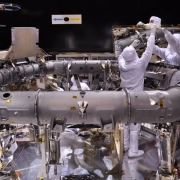Friday 6th December 2024 New Results from Gaia
Crystallising white dwarfs, spinning minor planets, and our Galaxy’s dark matter halo
Professor Michael Perryman
The image shows the integration of the M1 primary mirror on the torus of the Gaia spacecraft © EADS Astrium SAS, France
Science populariser Ethan Siegel has described the European Space Agency’s Gaia mission as “One of the most remarkable space science missions that most people have never heard of”. It is 10 years into its pioneering objective of mapping out the three-dimensional positions and motions of two billion stars in our Galaxy and beyond. This is providing great advances in understanding the way that stars are born and evolve, and yielding remarkable insights into the structure and evolution of our own Galaxy.
I will look at just three examples of how astronomers are using these data: to peer inside white dwarfs and understand how they are cooling over billions of years, to examine how solar radiation pressure is re-arranging the orbits and rotation of thousands of minor planets in our Solar System, and to look at the fossil records of cannibalised galaxies in our Galaxy’s outer halo to see how our own Milky Way galaxy came into existence.
Michael Perryman obtained a degree in physics, and a PhD in radio astronomy, at Cambridge University. During a 30-year career with the European Space Agency, he was the scientific leader of the Hipparcos space astrometry mission between 1981-1997, and of the follow-on Gaia space astrometry mission between 1995-2008. He was Professor of Astronomy at Leiden University, The Netherlands, between 1993-2009, and has received various awards for his leadership of space astrometry, including the Gold Medal of the French Astronomical Society, the Academy Medal of the Royal Netherlands Academy of Arts & Sciences, the Tycho Brahe Prize of the European Astronomical Society, and the international Shaw Prize in Astronomy 2022. He has held a position as Adjunct Professor, University College Dublin since 2013.
A video recording is available here.

